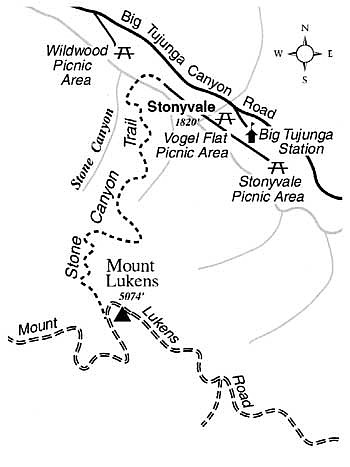 Facebook
Facebook
 X
X
 Instagram
Instagram
 TikTok
TikTok
 Youtube
Youtube
From the top of Mount Lukens, the high point in elevation within the city limit of Los Angeles, you can peer over a vast and spacious urban plain -- coastal haze and smog permitting. During the next five months temperatures should be mercifully cool for the strenuous climb to the top. Late fall and winter brings clearer, cleaner, and drier air -- which will benefit your lungs as well as the long views you'll get on top.
From the foothill community of Sunland, off Interstate 210, take either Oro Vista Avenue or Mt. Gleason Avenue north to Big Tujunga Canyon Road. Turn right and drive east into the canyon. Some seven miles up the canyon, look for the well-marked turnoff for Vogel Flat. Turn right, drive to the bottom of the hill, and park at Vogel Flat Picnic Area, open from 8 a.m. to 6 p.m. A short way east is Stonyvale Picnic Area, open 6 a.m. to 10 p.m. -- useful if you arrive early or will be returning late. A National Forest Adventure Pass is needed for parking.
On foot, head west down a narrow, paved road (private, but with public easement) through the cabin community of Stonyvale. When the pavement ends after 0.7 mile, continue on dirt for another one-quarter mile or so. Choose a place to ford Big Tujunga creek, step or wade across, and find the Stone Canyon Trail on the far bank. From afar you can spot this trail going straight up the sloping terrace just left (east) of Stone Canyon's wide, boulder-filled mouth. Once you're on that terrace, settle into a pace that will allow you to persevere over the next three miles and 3200 feet of vertical ascent.
From the vantage point of the first switchback, you can look down on the thousands of storm-tossed granitic boulders filling Stone Canyon from wall to wall. Although Stone Canyon's boulders are frozen in place, you can almost sense their movement over geologic time. Even today floods continue to reshape this canyon and many other steep canyons in the San Gabriel Mountains.
Ahead, there are many twists and turns along precipitous slopes covered by chaparral. The dizzying view from the midpoint of the trail encompasses a long, obviously linear stretch of Big Tujunga Canyon. This segment of the canyon is traced by the San Gabriel Fault and its offshoot, the Sierra Madre Fault.
You'll eventually come to a steep, bulldozed track leading to the bald summit ridge of Mount Lukens. Go 0.5 mile farther to the highest point on the ridge, the peak itself, which is occupied by several antenna structures. The view, north and east across the various ridges and peaks of the San Gabriels, and south and west across the endlessly spreading city, can be fabulous -- but only on a clear day.


From the top of Mount Lukens, the high point in elevation within the city limit of Los Angeles, you can peer over a vast and spacious urban plain -- coastal haze and smog permitting. During the next five months temperatures should be mercifully cool for the strenuous climb to the top. Late fall and winter brings clearer, cleaner, and drier air -- which will benefit your lungs as well as the long views you'll get on top.
From the foothill community of Sunland, off Interstate 210, take either Oro Vista Avenue or Mt. Gleason Avenue north to Big Tujunga Canyon Road. Turn right and drive east into the canyon. Some seven miles up the canyon, look for the well-marked turnoff for Vogel Flat. Turn right, drive to the bottom of the hill, and park at Vogel Flat Picnic Area, open from 8 a.m. to 6 p.m. A short way east is Stonyvale Picnic Area, open 6 a.m. to 10 p.m. -- useful if you arrive early or will be returning late. A National Forest Adventure Pass is needed for parking.
On foot, head west down a narrow, paved road (private, but with public easement) through the cabin community of Stonyvale. When the pavement ends after 0.7 mile, continue on dirt for another one-quarter mile or so. Choose a place to ford Big Tujunga creek, step or wade across, and find the Stone Canyon Trail on the far bank. From afar you can spot this trail going straight up the sloping terrace just left (east) of Stone Canyon's wide, boulder-filled mouth. Once you're on that terrace, settle into a pace that will allow you to persevere over the next three miles and 3200 feet of vertical ascent.
From the vantage point of the first switchback, you can look down on the thousands of storm-tossed granitic boulders filling Stone Canyon from wall to wall. Although Stone Canyon's boulders are frozen in place, you can almost sense their movement over geologic time. Even today floods continue to reshape this canyon and many other steep canyons in the San Gabriel Mountains.
Ahead, there are many twists and turns along precipitous slopes covered by chaparral. The dizzying view from the midpoint of the trail encompasses a long, obviously linear stretch of Big Tujunga Canyon. This segment of the canyon is traced by the San Gabriel Fault and its offshoot, the Sierra Madre Fault.
You'll eventually come to a steep, bulldozed track leading to the bald summit ridge of Mount Lukens. Go 0.5 mile farther to the highest point on the ridge, the peak itself, which is occupied by several antenna structures. The view, north and east across the various ridges and peaks of the San Gabriels, and south and west across the endlessly spreading city, can be fabulous -- but only on a clear day.
